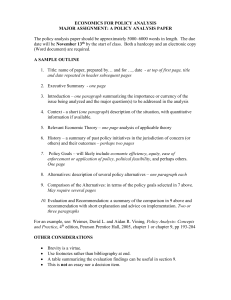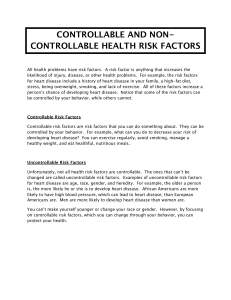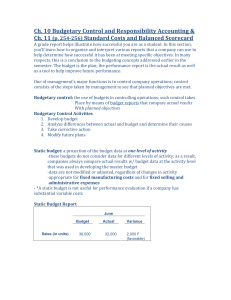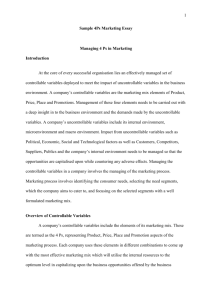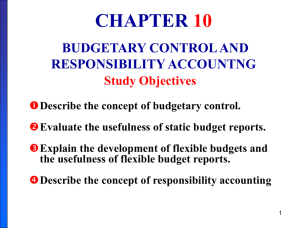GUIDELINES FOR CASE ANALYSIS MKTG 454 Advanced
advertisement
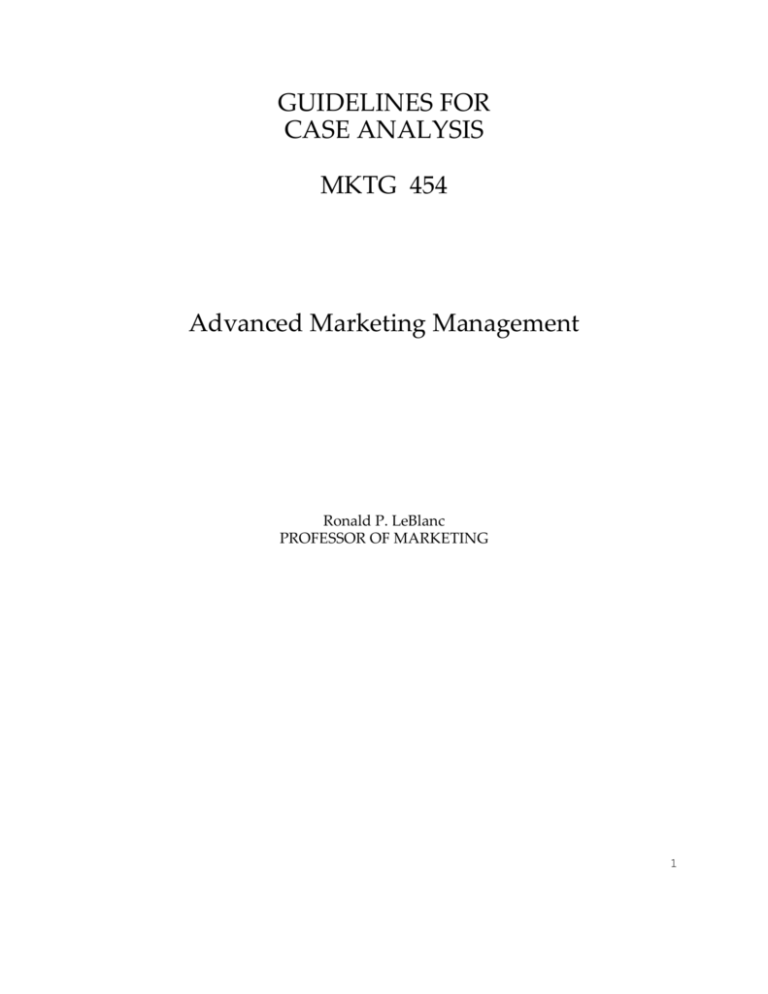
GUIDELINES FOR CASE ANALYSIS MKTG 454 Advanced Marketing Management Ronald P. LeBlanc PROFESSOR OF MARKETING 1 A. Cases and the Case Method of Instruction 1. What is a "Case"? I use the term "case" to refer to a description of a situation involving an organization operating in an environment and engaging in a certain set of business activities. Cases describe the activities the organization has performed and generally indicate whether these activities have been successful or unsuccessful in terms of the goals they were intended to accomplish. Cases are written with specific intent. Authors provide information and data for specific pedagogical reasons. There is a correct way the author's want the data analyzed so it may be used correctly in taking a position in your recommendation. Strategic and tactical decision making situations are created so that you are forced to make a managerial decision. Your class participation grade is highly correlated with your ability to "solve" the case in line with the author's design of the case. This means getting the situation analysis done correctly and then being able to use your analysis to "take a position and defend it." If your underlying analysis is correct - quantitative and qualitative - and you have no flaws in logic; you cannot be faulted for your solution. 2. What is "Case Analysis"? The term "case analysis" refers to a systematic process of examining all the available information related to the case and performing the following steps: a. Putting all of the information in the case together to produce a coherent picture or "map" of the situation. b. Evaluating the actions and plans of the company and identifying and describing business problems. c. Recommending a coordinated plan of action to correct business problems. d. Providing a justification or rationale for the recommended plan of action. Each of these steps in the case analysis process is described in greater detail below. 3. What Purpose is Served by Case Analysis in this Course? The process of case analysis provides students with the closest available approximation to the experience of being a manager. Case analysis serves as a substitute for large amount of actual business experience. Although case analysis is based on descriptions of business situations rather than the business situations themselves, it provides the best 2 means for helping the student grasp the tasks of the manager. The case analysis process provides the student with an opportunity to apply the concepts introduced across multiple business core classes. 4. Learning to Analyze Business Cases. These guidelines will not tell you everything you need to know to do case analyses. The guidelines should help orient you to the process of case analysis and should provide you with a general set of instructions on how to proceed. Case analysis is a mental skill that, like other skills; requires thoughtful effort and regular, systematic practice in order to achieve some degree of proficiency. No two cases are exactly alike, so it is impossible to reduce the procedures for case analysis to a rigidly defined "recipe" or "formula." However, the sequence of steps described below provides a logical and systematic approach to the case analysis process. B. The First Step in a Case Analysis -- The Situation Analysis The first problem encountered in case analysis is that the case description contains a lot of information of varying degrees of relevance and reliability (facts, opinion about facts, unsupported beliefs, etc.) that are typically presented in some more or less organized way. The first task in the process of case analysis is to use the information presented to construct a description or map of the organization's situation. This process goes well beyond simply reading and understanding the information presented in the case: it requires an active process of interpreting this information, of looking for relationships among items of information, and of putting together patterns describing how the organization is adapting to its environment. The process of situation analysis may require the student to draw on personal sources of information about business practice, human behavior, sometimes necessary to draw on any knowledge you have in order to "understand what is going on" in the case. The analysis of the situation requires that the following questions be considered in dealing with marketing oriented cases: 1. 2. 3. 4. 5. What are the organization's goals? What resources does the organization have? Who are the organizations' intended, actual, or potential customers? What customer needs or wants is the organization attempting to satisfy? What is the organization's Basic Product/Market Strategy (i.e., how is the organization attempting to match its resources with customer needs)? 6. How are the organization's resources organized into a marketing mix? 7. Who are the organization's competitors and what are they doing? 8. What other environmental (i.e., social/cultural, economics, etc.) variables 3 may be relevant in this case? The "picture" or "map" of the situation that you can construct in any given case will be more or less clear and detailed depending on how much information is provided in the case data and how much information you can supply from your own knowledge of the world. Different individuals using the same case data may be able to construct analyses of the situation that differ in completeness. Interpretations of the facts presented will vary among individuals. Construct the most complete and accurate analysis of the situation that you can. In "real life" business situations, managers rarely have all the information they would like, "facts" are subject to differing interpretations, and differences (sometimes bitter) will occur in how different managers analyze the same situation. The typical "analysis of the situation" involves so many individual items of information (both those presented by the case data and those "brought to the case" by the analyst) and involves so many relationships among the various elements of information, that writing an exhaustive or fully specified analysis of the situation becomes burdensome. Thus, it is generally most useful to "think through" the analysis of the situation in detail and to make written notes summarizing the principal aspects of the situation only. When a case is to be presented, the situation analysis is what is used to support a recommended course of action. The situation analysis is never presented as a standalone section of an oral or written presentation. C. Written or Oral Presentation of a Case State the Problem or Problems The situation analysis is used to sift through the facts in the case and identify specific business problems. Depending on the case, these problems may be numerous or few, severe or relatively minor. The task of the case analyst is to identify and describe problems and evaluate their seriousness. Marketing problems are frequently interdependent therefore, it is important to look for logical interrelationships among problems. Do several problems result from the same basic cause or "root problem"? Are problems linked together in a chain of cause-effect relationships? It is important to consider these possibilities. 4 1. What is a "Marketing Problem"? It is also necessary to clarify what is meant by the term "marketing problem" as it is used here. In common usage the word "problem" has a very broad and general set of meanings. The term "marketing problem" has a much narrower and more restrictive meaning. The organization cannot change the environment to any great extent. The organization achieves its goals by combining its resources in a manner that enables it to adapt to the situations presented by the environment. This adaptation to changing environmental situation is accomplished by making changes in the variables that are controllable by the organization. These variables include: a. The basic product/market strategy. b. The elements of the marketing mix (product, place (distribution), promotion, and pricing.) c. The organization established to administer the organization's marketing program. Thus, any marketing problem can be reduced to a set of "errors" or "maladjustment" in the design or administration of the controllable marketing management variables. Declining sales may certainly be a problem for the organization, but declining sales is not a marketing problem. Sales (or lack of them) are the result of the effects produced by the controllable marketing management variables over some period. Therefore declining sales can be symptom or sign that a marketing problem exists. The marketing problem itself consists in what was "wrong" with the design or administration of the controllable marketing management variables. Consider the two following examples of typical marketing problems: EXAMPLE # 1: The organization has a problem with distribution. Customers like the product, thought the price was right, and were persuaded by the promotion to buy, but the product was available in only a few stores. Many customers reported being unable to find the product. EXAMPLE # 2: The organization failed to develop a viable basic product/ market strategy. The organization got so enthusiastic about the technology of the product, which they failed to consider how the potential customers perceived their needs and whether the customers would perceive any advantage offered by the new product over competing products. It is crucial to successful case analysis that every symptom of an inefficient or unsuccessful adaptation by the organization to the to the environment be traced back to some underlying maladjustment or error in the design or administration of a controllable marketing management variable. The more specifically this maladjustment can be described and documented, the more useful the statement of the marketing 5 problem and the easier it becomes to recommend appropriate corrective action. Identifying all significant problems clearly and in specific detail is essential to the successful analysis of a marketing case. The most common and costly student error in case analysis is the failure to identify and describe marketing problems accurately and in sufficient detail. 2. Identifying a Set of Reasonable Alternatives. Once problems are identified, alternative courses of action that management can take are identifiable. The list of alternatives that should be considered is sometimes choices that are being argued in the case. In other cases, the student needs to consider alternatives that are not being discussed in the case. It is the student's task to develop a set of reasonable alternatives. The alternatives must be related to the problem(s) identified. 3. Make a Recommendation and Justifying the Selected Course of Action. a. As well as you can determine the recommended changes should be economically rational. That is, the economic benefits that you expect to result from the changes proposed must reasonably be expected to exceed the expected costs of implementing the changes. b. Actions recommended should be logically consistent with the problems identified. The set of actions recommended should correct all of the set of problems defined. No "surplus" or "gratuitous" actions unrelated to an identified problem should be recommended. Action necessarily requires consuming some of the organization's scarce resources. This consumption of resources should have as a clearly defined purpose the correction of an identified marketing problem. c. All changes recommended must be applicable to the "present" situation in the case. Frequently the case data will describe errors or opportunities that occurred before the "present" case situation. If these errors or opportunities are no longer a part of the organization's situation, they cannot constitute current marketing problems or be affected by action in the present. Action must be intended to influence how the organization adjusts to its present and anticipated future environment. 6 D. Justifying a Course of Action. In some instances, the clear definition of a problem will lead to the recommendation of a course of action that appears logically "obvious". Consider the following example: Problem: The organization has a distribution problem because the market segment it knows how to serve and intends to continue serving is moving to the suburbs, but the organization's stores are all in small cities and the downtown shopping districts of large cities. Action: Relocate stores in the suburbs. In other cases the problems may be sufficiently complex or the number of feasible alternative courses of action sufficiently great that some justification or rational is required to explain why the particular course of action recommended is the best alternative. In some cases it may be necessary to explain why or how the recommended course of action will solve or correct the problem. In still other cases, a sequence of actions may be required in which the choice of the second action from among a set of alternatives depends on the outcome of the application of the first action. For example, it may be necessary to change the price of the product so sufficient revenues are available to increase the level of advertising or switch to more expensive media. In written case analyses students must use their judgment concerning how much, if any, justification or explanation is needed to support any particular recommended course of action. E. A Note on the Case Process. Many students are at first uncomfortable in a case class. The problem stems from the type of learning process that takes place. Most classes that students have had are courses where material is covered and then the student is tested over that material. Case courses are not delivered in this fashion. The burden is on the student to use a set of business tools that have been required in the program. The professor can comment on the problem solving process and the strength of the arguments only after students have delivered them. In most case courses the students learn by making mistakes early in the course and learning not to make the same type of mistakes as the course progresses. 7
